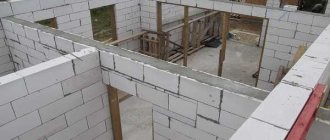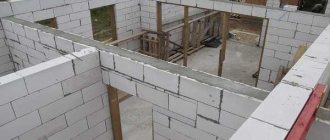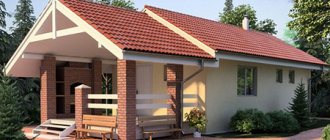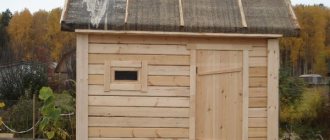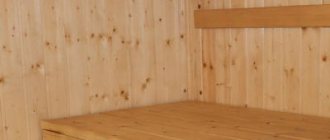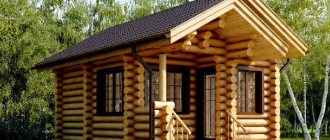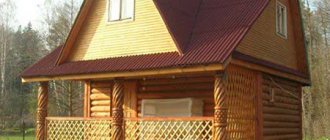Technologies in construction are developing by leaps and bounds. New materials are emerging that make it possible to build faster, without losing quality. And although aerated concrete is not an innovation - it is already three or four decades old - bathhouses have not been built from it before: this material has a fairly high hygroscopicity. But new impregnations have appeared that can significantly reduce the amount of moisture that the material absorbs. But even without impregnation, using modern vapor and waterproofing, you can achieve good results. The average lifespan of a bathhouse made of foam blocks is about 20-30 years. If you're happy with this, start looking for a project.
A gas silicate bathhouse can be built “with one hand”, and the process goes quickly: the blocks are large but light
You just have to remember that aerated concrete is produced using two technologies. In the production of some, hardening occurs in an autoclave - these are gas-concrete and gas silicate. When producing others (foam concrete), a foaming agent is simply added, then the foamed solution is poured into molds and hardens in air.
Autoclaved cellular concrete is considered to be of higher quality. An autoclave is not a cheap piece of equipment, so you can’t make the material using a homemade method. This is reflected in the cost - gas silicate is more expensive than foam concrete - but the geometry of the material and its quality are usually much better. Since it is desirable to make the seams between the blocks as thin as possible, the geometry is very important. Therefore, when purchasing, look for gas silicate blocks with the least deviations. Even if they are more expensive, you will save as a result: the glue costs a lot, if you can make a 1-2 mm seam, its consumption will be small. In addition, with such a seam there will be less heat loss, which means that it will be possible to make a smaller layer of insulation (if they are insulated) and less fuel will be consumed to heat the bath.
It is easy to distinguish gas silicate: due to the fact that lime is the binding element in it, it has a white color. The rest of the porous concrete is gray.
The gas silicate block is easy to distinguish: by color
Planning projects
Sometimes when building gas silicate baths, difficulties arise with the layout and location of the premises. The idea can be taken from ready-made projects and, if necessary, modified slightly.
If we are talking about small baths, then they most often have three rooms: a relaxation room, which is combined with a locker room, a washing room and a steam room. Some have a veranda or porch attached.
Layout options for a 6 by 3 bath made of gas silicate blocks
Medium-sized baths may already have a dedicated changing room, as well as a vestibule or hall. A vestibule or hall is desirable, since if the front door leads directly to the rest room, then in winter every opening of the door threatens a sharp drop in temperature. Therefore, at least a small vestibule is needed. If it is not possible to fence it off from the rest room, then you can attach it outside. Let it be small, but closed and insulated.
No one argues about whether a locker room is needed (if space allows). The dispute is about where her door should go. There are actually two options: in the sink and the rest room. Both are imperfect. If the doors of the locker room open into the rest room, after undressing you will have to go through it. If there is no one there, that’s one thing, but if people are resting, that’s another. The second option - the doors open into the washing room - usually does not have this drawback. But in such a room the clothes will be damp. So you have to choose: either a naked fashion show or raw clothes. Although the problem of dampness can be solved by making good forced ventilation in the locker room: the supply hole is at the bottom, the exhaust hole is at the top, and there is an exhaust fan in it.
Bathhouse layout 6*4.45 m
In its entirety, the bathhouse has a large length of 7.4 m since it has a veranda attached to it. It consists of three rooms:
Project of a gas silicate bathhouse 6x4
- rest room 13.66 m2;
- sink area 4 m2;
- steam room 5.8 m2;
- veranda 4 m2.
In this case, a vestibule can be made by moving the steps and installing doors. And the locker room can be fenced off at the end of the rest room opposite the entrance. Then, really, you will have to install a smaller window, or make two small ones: one in the rest room, the second in the locker room.
Bathhouse 5*5 with terrace
In this bathhouse layout, a rather large terrace is made of gas silicate - it has an area of 7.5 square meters. (Projects of bathhouses with terraces are here) Of the interior spaces, the steam room has the largest size - 5.8 m2, all the others are smaller. Non-standard solution. Usually the steam room is made small. But why not? The stove is installed in the wall between the steam room and the washing room.
Projects for a 6x4 gas silicate bath
Premises area:
- rest room/locker room 3.8 m2;
- sink 4.5 m2;
- steam room 5.8 m2;
- veranda 7.5 m2.
There are no options for changes here: the small size of the premises does not allow any liberties. But on the veranda you can have a pleasant time in the warm season.
Project bathhouse 6*6 made of gas silicate blocks with a terrace
In this layout, 6*6 is the size of the bathhouse itself, and the terrace is another two meters. In total, in terms of plan, the entire building will occupy 6*8 meters. The approach is more standard: the largest area is in the rest room. The steam room and the washing room are almost equal in size.
Project of a foam concrete bathhouse with a terrace and a large relaxation room
The stove is positioned so that it is heated from the rest room. The decision is ambiguous. As far as heating is concerned, everything is fine: the rest room will also be warm. But if you need to add firewood, and there are no people outside the steam room in the bathhouse, you will have to go through the shower and go to the rest room. Nothing terrible, but not everyone will like this option. Although installing a stove with a remote firebox is the most popular option recently.
Area of premises in a 6 by 6 bath:
- recreation room 16.2 m2;
- sink 5.5 m2;
- steam room 5.2 m2;
- hall 3.2 m2;
- terrace 12.3 m2
Drawing of a gas silicate bath
Opinions of block bathhouse owners
If you follow all the rules during the construction of a bathhouse, then no nuances or unforeseen issues should arise. The main thing is to purchase high-quality material so that it is not damaged during delivery. Below we will look at a few reviews of what owners think about their block saunas.
“We have been using our bathhouse, which we built ourselves, for more than a year. Its dimensions are 3x3 m, and, to be honest, we really like it. We also made the stove ourselves, while adhering to all fire safety regulations. We placed it horizontally. The interior of the bathhouse was decorated with wooden clapboards, and the exterior was lined with brick.
“Our bathhouse is made of a polystyrene block, its dimensions are 5x4.5 m. We have been using it for about two years. Until now we used a wood-burning stove, but now we decided to replace it with a Tunguska stove. The inside of the bathhouse was insulated with foil and lined with aspen clapboard. The outside was simply plastered and painted. The result is impeccable functioning of the bathhouse and only positive emotions. The sauna warms up in a couple of hours and holds the heat just fine.”
“I want to share what kind of bathhouse I built for myself. It is already almost 8 years old, and this despite the fact that it was built from foam concrete blocks. Their thickness is 10 cm. Foil film was used as insulation, and the sheathing was done with linden clapboard. In winter, we heat it once a week, and this is at -30 oC. The brick stove reaches the required temperature in the bathhouse in an hour and a half. You can steam as much as you like.
There are no foreign odors felt at all inside the bathhouse; the outside was simply whitewashed. We spent a long time choosing which foam blocks were best for a bathhouse until we found the right option. The construction of the walls was as fast as possible, with a minimum of effort. The blocks are easy to process; a simple hacksaw will do for cutting, and for drilling you only need a simple drill. It took only two days to build the walls, despite the fact that only one person helped me - a medium-sized bathhouse.”
Finally
To summarize, we can say with confidence that a bathhouse made of blocks is a completely worthy option. If you have a limited budget or time, such a bathhouse is really worth building.
Features of construction from gas silicate
Pouring the foundation and erecting walls during the construction of a bathhouse is no different from similar processes during the construction of a house. The foundation for bathhouses is often made of strip foundations, the depth is below freezing of the soil. The width of the tape depends on the size of the block that will be used during construction.
Adhesive for gas silicate - cellular betor. Diluted with water. Dosage and order are indicated on the package
Particular attention must be paid to horizontal waterproofing. Previously, and even today, roofing felt was most often laid in two layers. But roofing felt is bituminous mastic applied to a layer of construction cardboard. At one time it was good material, and there was simply no alternative to it. But it has one very significant drawback: it does not have the longest service life (35 years depending on conditions). Today there are similar rolled materials made using practically the same technology, but based on fiberglass (more durable) or fiberglass. It is better to use them - they are more elastic and do not lose their properties for a long time.
Place the gas silicate on a special glue, which is diluted with water to a semi-liquid state. Only the bottom row is laid on cement-sand mortar. All the rest - on a thin layer of glue (no more than 5 mm, and better - 1 mm). Every 3-4 rows it is recommended to lay two reinforcement bars (ribbed with a diameter of 12-14 mm). The grooves are cut out for them using a circular saw, an angle grinder or a hand-held wall cutter, which is made specifically for foam concrete.
Pay attention to how the reinforcement is laid at the junction of the walls - it is bent and a whole frame is laid
The adhesive composition is applied using a carriage or a special trowel - a scoop with teeth. Clean the block from dust and dirt, apply glue to the end where it will be joined to the next block, and carefully place it. Correct the position with a rubber mallet.
The masonry is carried out similarly to brick - with ligation - covering the seam of the bottom row with the body of the block in the next row. To ensure that the rows of masonry are even, use a building level and pull the cord - the mooring. The verticality of walls and corners is controlled by a plumb line.
When laying blocks, the seams are made very thin - no more than 5 mm. This allows you to save money on glue, but also increases the thermal insulation characteristics of the wall. The glue conducts heat well, so the smaller the cold bridges, the better. The layer is applied using a special trowel or carriage. If necessary, you can level it with a large notched trowel, which is usually used by tilers.
Apply glue to the back of the laid block and to the side of the one standing next to it.
For more information about tools for working with foam blocks, read the article “How to choose trowels and other tools”
Since gas silicate material is soft, they cannot bear any serious loads. Therefore, when installing the floor, the logs rest on the foundation. It is specially made wider than the blocks, and the edge of the wall is aligned with the edge of the tape. In some cases, the blocks are moved 10 centimeters outward. It turns out that the wall seems to hang over the foundation. This simple technique increases the internal dimensions of the premises. And the resulting depression is then covered with insulation (expanded polystyrene boards) and waterproofing. Read about foundation waterproofing here.
The situation with the roof is standard: a thick wooden beam - a mauerlat - is laid on the top row, and the entire system is already attached to it. There is a second option: filling the armored belt. Then formwork is installed or special U-shaped blocks are used, into which four interconnected reinforcement bars are placed (longitudinal thickness 10-12 mm, transverse thickness 6-8 mm).
According to the thickness of the wall. Recommended - 25-35 cm, depending on the region. In terms of density, gas silicates of two grades D400 and D500 are most often used. The first has a lower density, the second has a higher density, and accordingly the D500 is more durable. But in terms of thermal insulation characteristics, D400 is better - walls built using it are warmer.
Table of characteristics of gas silicate of different densities
How to build?
Building a bathhouse from blocks with your own hands is much easier than doing the same process from wood.
First, you need to familiarize yourself with some detailed step-by-step recommendations:
- First: the construction of any building always begins with a project. If everything is ready here, you can immediately move on to the second step.
- Second: even such a light building as a bathhouse made of blocks must be placed on a foundation. The choice of a particular type of foundation for your building is made based on the quality of the soil underneath it.
A strip foundation is the most suitable basis for a block bathhouse on almost any soil. To make a smooth and durable strip base, you need to make the correct markings. Excavate a trench of the required width and depth along the perimeter of the future building and partitions inside it. Next, the formwork is installed. A layer of sand no more than 15 cm is compacted at the bottom of the trenches.
We lay a reinforced base (mesh, rods, etc.) on the sand. Having prepared the solution, pour it into the formwork, filling all the voids. After 7 days, the support can be removed. We continue to let the foundation stand, periodically wetting it with water to avoid cracking. You can lay blocks on top of the base only after a month.
- Third: block masonry. Waterproofing is done on top of the dried and cured foundation. Despite the fact that the blocks are laid using special glue, it is recommended to fasten the first two rows together using standard cement mortar. Laying begins from the corners of the structure. In this case, each corner block should protrude 0.5 cm beyond the foundation. It is advisable to check each row with a level. Do not forget to lay reinforcement every 3-4 rows. And also in openings. This will make the structure stronger.
- Fourth: when the walls are rebuilt, you can begin to design the floor screed.
You can see the approximate structure of the insulation layers of aerated concrete slabs in the bathhouse in the photo.
Ventilation
When building baths from any material, the main task is to ensure good drying of all rooms after the bath. Then there will be no problems with fungi and mold.
When building a bathhouse from gas silicate blocks with your own hands, do not forget to leave ventilation holes at the top and bottom of the wall in each room. They can probably be cut out later, but why complicate your life. To prevent suction from them while vaping, they are closed with doors. And they don’t go into the room - they end up under the insulation. Their task is to remove all steam from under the casing after visiting the steam room.
One of the options for external insulation of walls made of foam blocks with subsequent finishing
Advantages of gas silicate
Let us dwell in detail on the features of gas silicate, which ensure the possibility of its use as a building material for the construction of a bathhouse.
Even at the planning stage, the finishing of the bathhouse is thought out, since it will have to be done on both sides, and a lot of money will be required
Main advantages:
- affordable, compared to wooden logs and traditional bricks, price, reducing the cost of building a bathhouse;
- ease of masonry associated with clear geometry and increased dimensions of lightweight products;
- resistance to mold, mildew, impossibility of reducing strength characteristics as a result of rotting of environmentally friendly building materials;
- resistance, unlike wood, to the effects of open fire, increased temperature, which is achieved indoors as a result of heating;
- increased strength characteristics, resistance to the effects of multiple cycles of freezing with subsequent thawing, makes it possible to ensure the stability and long service life of the bathhouse being built, which is occasionally subjected to sudden temperature changes when the room is heated;
- increased level of sound insulation, making it difficult for extraneous noise to penetrate into the room;
- the insignificant mass of the blocks allows for quick laying and the formation of a lightweight foundation;
- increased thermal insulation characteristics associated with the cellular structure of the porous composite. The air cavities located inside the concrete mass are a heat insulator, allowing the walls to better retain heat inside the room and warm up faster.
Gas silicate blocks are produced from a mixture of materials: lime, gypsum, cement and aluminum powder
Insulation
The outside of a bathhouse made of gas silicate blocks is insulated depending on the region. In central Russia, 10 cm of basalt wool is enough. In more northern regions, more is needed, in southern regions less. The use of mineral wool is associated with certain difficulties: it is afraid of moisture and loses its properties when wet. And if it freezes wet, it will simply crumble. But that's not all. Since the foam block is quite hygroscopic, it also needs to be protected from moisture. Therefore, before laying the insulation, it is treated with impregnation such as Penetron or Kalmatron. After drying, you can begin thermal insulation.
Based on all this, it makes sense to spend money on the purchase of extruded polystyrene. It itself does not absorb water or conduct it, has low thermal conductivity, and is not damaged by rodents and insects. This one material, laid without cracks, will be both hydro- and thermal insulation.
The sheathing is stuffed on top of the insulation, and then the sheathing is added to it. You can attach a painting mesh to polystyrene foam and plaster over it - if this type of finishing appeals to you more.
Options for finishing and insulating foam concrete walls
The inside of the steam room will be insulated as follows (from the wall to the steam room):
- cement-based impregnation that reduces hygroscopicity;
- block 50*40 m;
- there is a heat insulator between them;
- steam and hydrobarrier - usually foil film (you glue the joints and fasteners with special tape - buy it in the same place where you buy the film);
- counter-lattice at least 2.5 cm thick;
- lining.
In other rooms, including the washing room, insulation may not be installed. If you also cover the washing area with clapboard, then a vapor barrier film should remain. It may no longer be foil-coated (this is mainly only for steam rooms), but both it and the impregnation should be there. In the remaining, “dry” rooms, the impregnation remains (the humidity is still high), the lathing, and the lining is stuffed to it.
The walls are covered with sheathing - preparation for laying insulation
The ceiling insulation in the steam room is standard (from bottom to top, when viewed from the steam room):
- lining;
- vapor barrier film (foil);
- rough ceiling;
- insulation from the attic.
Moreover, a ventilation gap is required between the lining and the vapor barrier. It is organized using a counter-lattice. Read more about insulating the ceiling of a steam room in the article “How to insulate the ceiling in a bathhouse with your own hands”
Cladding the rest room and attic
For the cladding I used the same aspen paneling as in the steam room. I just sewed it onto the slats horizontally. I did not use any vapor or thermal insulation.
First of all, I attached vertical slats (made of boards) to the gas silicate walls. I nailed the clapboard to them with nails.
Vertical slats are mounted on gas silicate blocks using wood screws
The walls of the rest room were covered with aspen paneling horizontally
Upon completion of the work, I covered the lining with antiseptic impregnation “Drevnokhron oak” (Polifarb) in 2 layers. The second layer was applied after the first had dried, that is, the next day.
Finishing in the steam room and washing room
No matter how hard you try to do a vapor barrier, water will still seep under all the layers and settle in the wall. To minimize its amount, it is better to tiled the walls in the washing room. If you are afraid that it will be cold, make a warm floor (you can also use the walls).
In the steam room, also lay the floor and part of the wall - to a height of 10 cm or higher - with tiles. And then there’s the whole “pie” in full.
If you take into account all these nuances when building a gas silicate bathhouse with your own hands, it will delight you for many years.
Block laying technology
Aerated blocks can be laid in several ways:
- Masonry “in one block” is performed for one- and two-story buildings. Blocks with a density of D500 are used, they retain heat well. You should start from the corners. After installing the corner blocks, you need to draw a string and check the evenness with a level or level. After laying the first row, you need to wait a couple of hours for it to harden, and then continue working. It is recommended to sand the surface of the previous one before laying the next row to increase adhesion.
- Laying in two blocks simplifies the work of builders. If according to the project the wall width is 40 mm, you can use two types of blocks - 15 mm and 25 mm. They will be much lighter and cheaper than one block, 400 mm wide. To prevent deformation, the blocks are laid in a checkerboard pattern. There are flat gas blocks and “groove-ridge” - this is a type of end surface that allows you to assemble a reliable structure. When laying in two blocks, it is better to use them.
Roof
The roof has one peculiarity: the roofing material must be light. It could be:
- soft roofing - made of rolled materials or soft bitumen tiles;
- corrugated sheeting;
- metal tiles;
- wooden roof.
The entire system is attached to the Mauerlat, and it is attached to the upper armored belt with long pins. When attaching the rafter system, everything is attached only to the beam. It is not worth attaching to the walls - there is no sense in it: gas silicate cannot withstand long-term point loads, it crumbles and cracks. That’s why an armored belt is needed.
Design Features
In order for an aerated concrete bathhouse to differ only in its advantages during operation and exclude the disadvantages characteristic of this material, it will be necessary to draw up a professional project for its construction. It can be done by a qualified construction organization that deals with this type of problem. In this case, the design documentation should take into account the following series of issues:
- A plan for the placement of the building on the site, as well as its external dimensions, a diagram of all internal premises (steam room, shower room, rest room, etc.) and their dimensions.
- Type of foundation, its characteristics.
- Type and quantity of required building materials.
- Plan of the supplied communications (water supply, gas pipeline, heating pipeline, sewerage, electricity, etc.).
- Type of heating equipment for the steam room.
- Pool layout and dimensions.
- Recommendations for hydro- and thermal insulation inside and outside.
Regardless of what the design of an aerated concrete bathhouse will be, there are strict construction norms SNiP, according to which the following is allowed:
- Locate the structure no closer than 20-30 m from the nearest body of water.
The location of the bathhouse on the site must comply with SNiP standards Source na-dache.pro
- Plant trees and bushes next to the paths to the bathhouse.
- Organize gravity drainage of wastewater by placing the structure on a hillock.
- Plan the building so that the exit is to the south and the windows are to the west.
However, it is prohibited to build it in such a way that:
- Sewage flowed into a nearby reservoir.
- There was no view of her from the windows of the house.
- The border or fence with the neighbor's property was less than 3 meters away.
- The distance to housing was less than 8 m.
Projects for aerated block baths can be both standard and individual - at the discretion of the future owner. A traditional Russian bathhouse has a small area and, as a rule, includes a steam room and an entrance hall or dressing room. More modern versions include more themed areas. An example is a typical project with the following premises:
- Dressing room – 1.8 m².
- Shower – 8 m².
- Steam room – 5 m².
- Recreation area – 12 m².
- Bathroom – 1.5 m².
Often, modern baths are built with an attic floor, which houses a fairly spacious recreation area.
Option for a modern aerated concrete bath with an attic floor Source stroy-podskazka.ru
Note! When choosing aerated concrete blocks, it is necessary to pay attention not only to external characteristics - size matching, evenness of edges, matching color parameters, uniformity of material, but also to the degree of frost resistance. For walls without external decoration, its value should be greater than for baths with facade decoration.
What kind of foundation is needed?
To build from aerated concrete blocks you will need a strip foundation. And it doesn’t matter that the structure itself will be light; on a different foundation, the bathhouse will not last for several years. This is due to the structure of the material itself. Although stones are strong enough to be used in the construction of load-bearing walls, they do not withstand bending loads well. That is why there are no buildings made of gas silicate higher than three floors, and there are few three-story buildings.
Slab foundation
The advantage of a solid monolithic slab is that it does not change its configuration during soil heaving. A movable foundation will lead either to constant minor repairs to the walls, or even to the destruction of the bathhouse itself.
As an option, you can use a pile structure, but reinforced concrete beams or a monolithic continuous reinforced belt must be installed on top of it.
Note!
Whatever foundation you choose, the base must be waterproofed and rise above the ground by at least 50 cm. Since gas silicate blocks are porous and absorb moisture well, they will collapse when alternating cycles of defrosting and freezing of the water inside.
Types of foam blocks
Foam blocks, depending on the manufacturing technology, may have different properties and some differences in appearance. The table below provides a description of the main varieties of this material.
Foam blocks are different
Table. Types of foam blocks.
| View | Description |
| Aerated concrete | This version of foam blocks is made from cement with the addition of aluminum powder. During the chemical reaction that occurs due to the addition of powder, pores are formed in the mixture. The future block is placed in an autoclave, where great pressure is applied to it, and the concrete hardens. The sizes of such blocks may differ from each other, this is due to the peculiarities of their manufacture. But deviations from the standards (average block dimensions 30x25x60 cm, weight - 30 kg) are, as a rule, insignificant, which makes it possible to obtain a minimal seam when laying blocks. Also, this version of foam blocks is called gas block or autoclaved foam concrete. The material is quite often used for the construction of baths and other structures. It is lightweight, conducts heat well, does not burn, and is not afraid of frost. It is also a fairly economical material and easy to process - it can be cut with a hacksaw. |
| Silica concrete | This type of block has a white color due to the addition of lime to the composition from which it is made. It is necessary to bind the mixture. This version of foam blocks has the highest hygroscopicity. There are a lot of pores in the structure of each block - 50% of the total volume. Due to the presence of a large number of voids, the blocks are very light and can be used for construction on light foundations. This material has excellent heat and sound insulation properties, so a bathhouse made from it will keep warm for a long time. |
| Foam concrete | This version of the foam block is produced in almost the same way as conventional aerated concrete, but without the effects of temperature. Concrete hardens naturally, but a special foaming agent is added to the mixture from which the block is made, after which the finished mass is poured into molds, in which it hardens naturally. |
| Sand block | These are blocks made of cement, water and sand. This is the standard mixture for creating concrete. Such blocks are economical, resistant to external factors, and environmentally friendly. They also have voids, but the blocks almost do not absorb water. The main disadvantage of the material is its low thermal conductivity, so a bathhouse made from it will have to be additionally insulated. And their mass is large, so it is not recommended to lay them on a weak foundation. |
Structural and thermal insulation block
Note that each of these types of materials is suitable for building a bathhouse for any project. It’s just that some materials need to be well protected from moisture during the construction process.
Prices for gas blocks
Gas block
Construction stages
Only at first glance it may seem that building a bathhouse from aerated concrete is an easy process that does not take much time and effort. In reality, this is a complex procedure consisting of the following important sequential steps:
- Construction of the foundation.
The most critical stage of construction, on which the condition of the structure will depend during the entire operational period. The parameters of the foundation directly depend on the characteristics of the soil and climate in the region. However, in most cases, a shallow reinforced foundation is sufficient for aerated concrete masonry.
For an aerated concrete bath, a shallow strip foundation is best suited Source profibrus.ru
The technology for its construction boils down to the following algorithm:
- Site preparation – cleaning, leveling.
- Marking according to plan.
- Digging a trench - about 0.6-0.7 m deep and about 30 cm wide.
- Creating a sand-crushed stone cushion at the bottom with a layer of about 20 cm.
- Formation and installation of formwork based on boards or slab material.
- Assembly of a frame inside the formwork from reinforcing sections and wire.
- Inserting pipe sections for laying communications.
- Filling with concrete grade not lower than 300M.
- Dismantling the formwork, 7-9 days after pouring.
In most cases, for a one-story bathhouse made of sibit, a foundation with a height of about 0.7-0.8 m is sufficient. Immediately before starting masonry, when the concrete has dried and gained sufficient strength, waterproofing is performed by applying a layer of mastic and lining horizontal surfaces with a special material.
- Formation of the first rows of masonry and laying partitions.
The formation of the 1st row of masonry is important for laying subsequent ones. The performance characteristics of the walls will depend on the evenness of its installation.
It is important to install the corner masonry blocks of the 1st row as accurately as possible Source ytimg.com
Therefore, during installation, the blocks must be checked with a building level along the horizontal and vertical planes. In addition to this rule, the following series of requirements are observed:
- The installation of the first row is carried out on cement mortar, which, if necessary, allows you to align the block along the desired plane.
- The second and subsequent rows begin to be laid on the glue with a layer of about 7 mm, when the mortar has already dried and hardened - that is, after 2 hours.
- Every 4th row of masonry must be reinforced with a special reinforcing mesh.
- To create partitions in the main masonry blocks, cuts 15-20 cm deep are made through the row.
Finishing
Finishing is necessary both externally and internally.
Insulation from outside
If you do not do external finishing, the walls will simply be blown through. So you need to at least prime (with Ceresit ST-17 primer), and then plaster (ST-24) with a layer a little more than half a centimeter thick. You can continue finishing after installing doors and windows. Since aerated concrete is a fragile structure, the frames should be wide and attached to the concrete with anchor bolts as large an area as possible, and caulked with jute or tow. More complex external insulation consists of many elements that are attached on top of the sheathing made. The prepared facade can be covered with plastic siding or decorative plaster.
Insulation of aerated concrete from the outside
Insulation inside
Craftsmen advise covering the steam room and the bathhouse as a whole with foam glass tiles - simply placing them on glue. It is heat-resistant and has low thermal conductivity.
Foam glass is laid like tiles
Then the walls can simply be covered with clapboard.
Covering a block bathhouse with clapboard
A “warm floor” is laid on the floors, and tiles are placed on it.
Warm floor under tiles
Important! Before interior finishing work, you need to install all electrical cables and install taps for the water supply system and drains for the sewerage system.
After laying the tiles, ladders are installed.
Tile with ladder
Let's assume that we have overcome all the difficulties and our bathhouse is ready.
Characteristic
Gas silicate block
Manufacturing proceeds as follows:
- Using special equipment, aluminum-based powder and Portland cement are combined.
- Next add water, ordinary cement and quartz sand.
The resulting samples have the following advantages:
Advantages
- Low cost. The absence of expensive components and additional processing processes that require brick and wood makes the cost of this material minimal.
- High thermal insulation. For a bathhouse, this is a very significant indicator, which also allows you to save on insulation for the bathhouse.
- Little weight. This indicator allows one person to carry out all the work.
One product can be easily lifted with one pair of hands
- Big sizes. Thanks to this, construction work goes much faster.
- Ease of processing. Any cutting can be easily done with your own hands using an accessible tool.
Cutting with a regular saw
- Fire safety. Complete non-flammability means there is no risk of fire from accidental exposure to open flame.
Flaw
It would be fair to note the disadvantage of gas silicate - extensive moisture absorption. Taking into account the fact that the bathhouse provides high humidity in the steam rooms, part of the savings must be spent on high-quality waterproofing.
Advantages and disadvantages
Block building materials have their pros and cons. You definitely need to know them if you plan to use blocks in the construction of a bathhouse. To begin with, it is worth considering in more detail what advantages such elements have.
There are several advantages of such material as blocks.
- A structure built from blocks will not shrink, like, for example, buildings made of wood.
- A steam room made of blocks can be built almost immediately after the main finishing.
- The construction of such a bathhouse will take a minimum amount of time.
- All repair work can be carried out without the involvement of outside help, but experts recommend inviting at least one assistant. This way construction will go much faster.
- The final cost of a block bath will be 2-3 times lower than in the case of building a wooden steam room of exactly the same dimensions.
- Block materials are absolutely safe for human health. They do not contain hazardous chemical compounds, so even at elevated temperatures they do not emit harmful substances.
- The blocks are relatively light in weight. Thanks to this characteristic, you can significantly save effort and money on preparing a high-quality foundation.
- Many consumers choose block materials for construction because they do not support combustion.
- A bathhouse made of blocks is not subject to rotting.
- The blocks are easy to maintain. They do not need to be regularly coated with antiseptic compounds, as is the case with wooden buildings. Block materials are not susceptible to mold and mildew.
- Walls built from such raw materials are “breathable” due to their diffuse properties.
- Many types of blocks, for example, gas silicate ones, boast good heat and sound insulation properties.
- The service life of quality blocks is very long.
As you can see, buildings made from blocks are very durable and wear-resistant.
Currently, many owners choose block materials for the construction of baths (and not only).
However, these products also have their disadvantages.
- The blocks absorb moisture, so the bathhouse must be provided with high-quality waterproofing, otherwise the material may simply collapse.
- A bathhouse made of blocks requires a vapor barrier. This is explained by the fact that condensation almost always accumulates inside walls made of such materials, so it is impossible to do without vapor barrier materials.
- Blocks are durable materials, but in this regard they are inferior to brick.
- Popular gas silicate blocks contain aluminum powder and lime. These components reduce the positive characteristics of the material.
Many problems associated with block baths can be completely avoided if they are constructed in a high-quality manner and also take care of hydro- and vapor barrier in advance.
